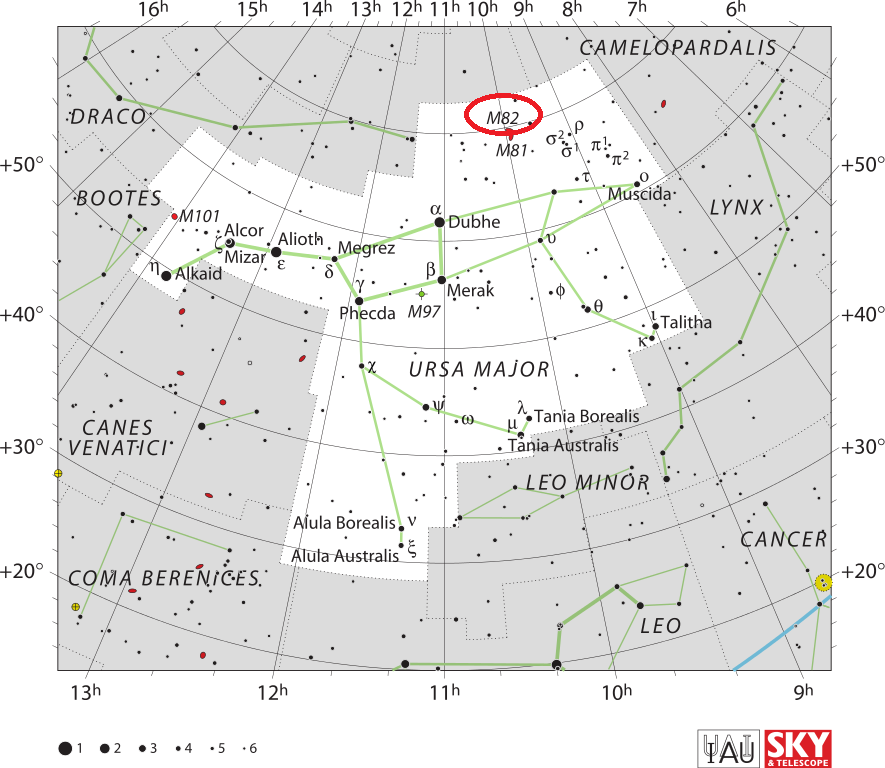Messier 82 (M82), also known as the Cigar Galaxy, is an edge-on starburst galaxy located in the constellation Ursa Major. The galaxy lies at a distance of 11.4 to 12.4 million light years from Earth and has an apparent magnitude of 8.41. It has the designation NGC 3034 in the New General Catalogue.
The Cigar Galaxy occupies an area of 11.2 by 4.3 arc minutes of apparent sky, which corresponds to a linear diameter of about 37,000 light years. In small telescopes, it forms an impressive pair with its larger neighbour, Bode’s Galaxy (M81), which appears face-on and lies only 38 arc minutes from M82.
Messier 82 can be found about 10 degrees northwest of Dubhe, Alpha Ursae Majoris, the star that marks the northwestern corner of the Big Dipper‘s bowl.
A line drawn from Phecda, Gamma Ursae Majoris, to Dubhe and extended by the same distance leads to the M81/M82 pair. M81 is located 38 arc minutes south of M82.
In binoculars and small telescopes, the Cigar Galaxy appears as a thin rod of light, while 6-inch and 8-inch telescopes reveal the bright core and dark patches across the galaxy’s surface. Larger instruments show more details of the galaxy’s structure. The best time of year to observe M81 and M82 is during the spring.
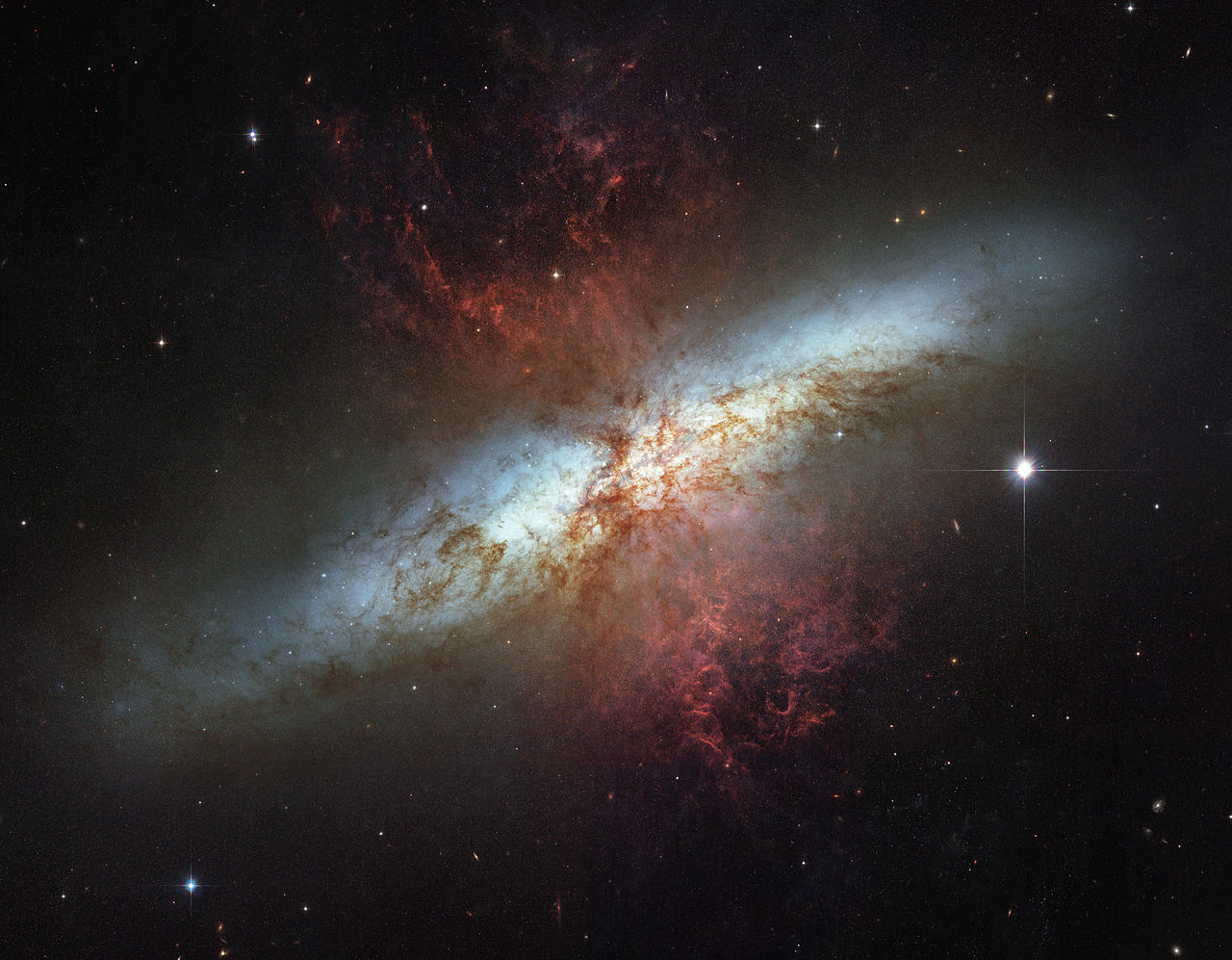
The observation was made in March 2006, with the Advanced Camera for Surveys’ Wide Field Channel. Astronomers assembled this six-image composite mosaic by combining exposures taken with four colored filters that capture starlight from visible and infrared wavelengths as well as the light from the glowing hydrogen filaments. Image: NASA, ESA, and The Hubble Heritage Team (STScI/AURA)
Messier 82 is about five times more luminous than our galaxy, the Milky Way, and about 100 times more luminous than the Milky Way’s centre. It is the closest starburst galaxy to Earth and serves as a prototype for this type of galaxy. M82 is one of the smallest galaxies listed in the Messier catalogue and inclined about 80 degrees to our view. The galaxy’s edge-on appearance has earned it the name Cigar. The galaxy is receding from us at 203 km/s.
The Cigar Galaxy was long believed to be an irregular galaxy. However, near-infrared observations in 2005 revealed two symmetric trailing spiral arms in the galaxy. The high surface brightness of the galaxy’s disk and our edge-on view of M82 are the main reasons why the spiral arms had not been detected sooner. M82 is usually classified as irregular, but is probably a distorted disk galaxy and a striking prototype of a class of starburst galaxies.
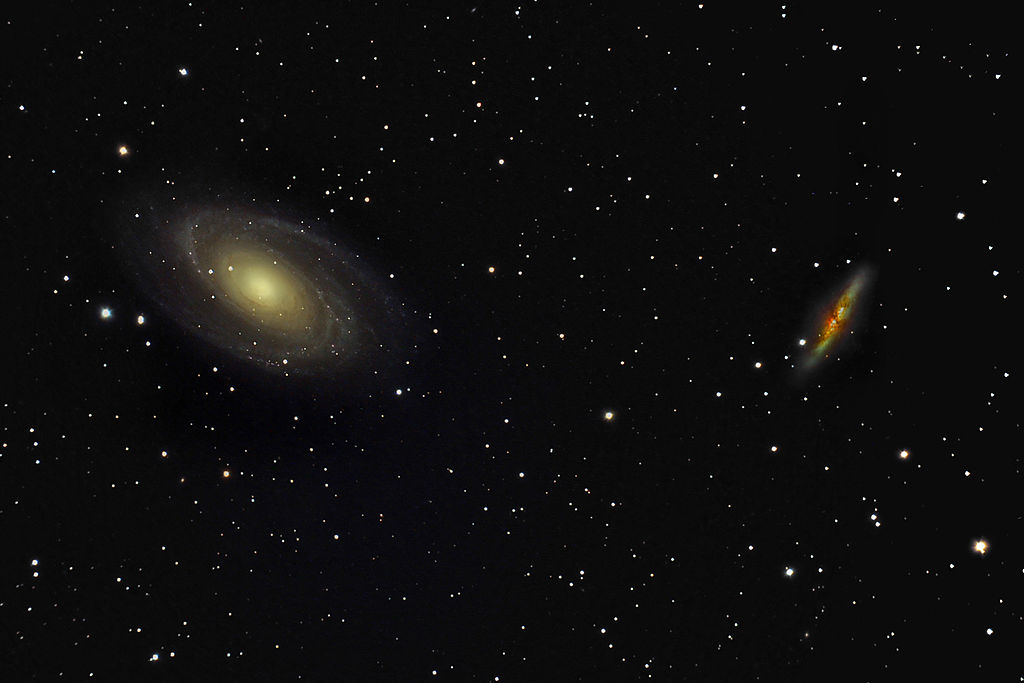
The star forming activity in M82 is caused by the galaxy’s interaction with its large neighbour, Bode’s Galaxy (M81), the central galaxy in the M81 Group, which also includes M82 and dozens of other galaxies in Ursa Major. The centres of the Cigar Galaxy and Bode’s Galaxy are visually separated by approximately 130,000 light years.
The Cigar Galaxy is strongly affected by the interaction with M81, with tidal forces deforming the galaxy in a process that started some 100 million years ago. As a result of the encounter, star forming activity in M82 has increased tenfold compared to other galaxies.
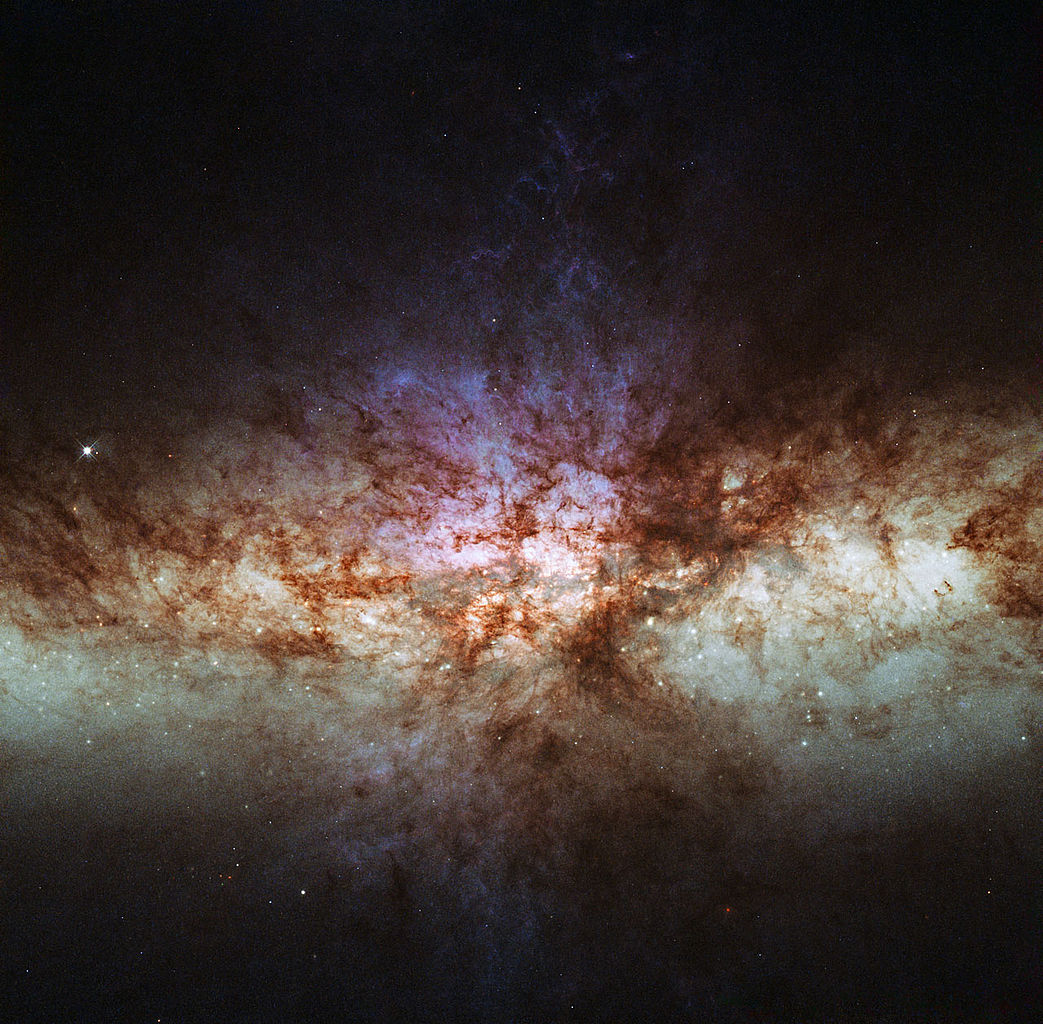
Using filters which allow through relatively broad bands of colours, similar to those our eyes see, results in natural-looking colours and bright stars, as starlight shines brightly across the spectrum.
Using filters transparent only to the wavelengths emitted by specific chemical elements, as in this image, isolates the light from glowing gas clouds, while blocking out much of the starlight. This explains why the stars appear faint in this image, and why the dust lanes are sharply silhouetted against the brightly glowing gas clouds. The image shows the light emitted by sulphur (shown in red), visible and ultraviolet light from oxygen (shown green and blue, respectively), and light from hydrogen (cyan). The field of view is approximately 2.7 by 2.7 arcminutes. Image: ESA/Hubble & NASA
Images taken by the Hubble Space Telescope in 2005 revealed 197 massive clusters of young stars in the core of M82. The clusters have an average mass of about 200,000 solar masses. The rate of star formation in the galaxy’s core is about 10 times faster than that in our entire galaxy and the active starburst region occupies an area that is 500 parsecs in diameter.
The core of M82 is a strong source of radio emissions. Originally named Ursa Major A, the radio source is now known as 3C 231. It is the strongest source of radio emissions in Ursa Major.
The Cigar Galaxy is the brightest galaxy in the sky in infrared wavelengths. It shows an infrared excess, which is to say, it is significantly brighter in infrared than in visible light. Other galaxies that share this characteristic include Centaurus A, a bright peculiar galaxy located in the constellation Centaurus, and NGC 5195, the companion of Messier 51 (Whirlpool Galaxy).
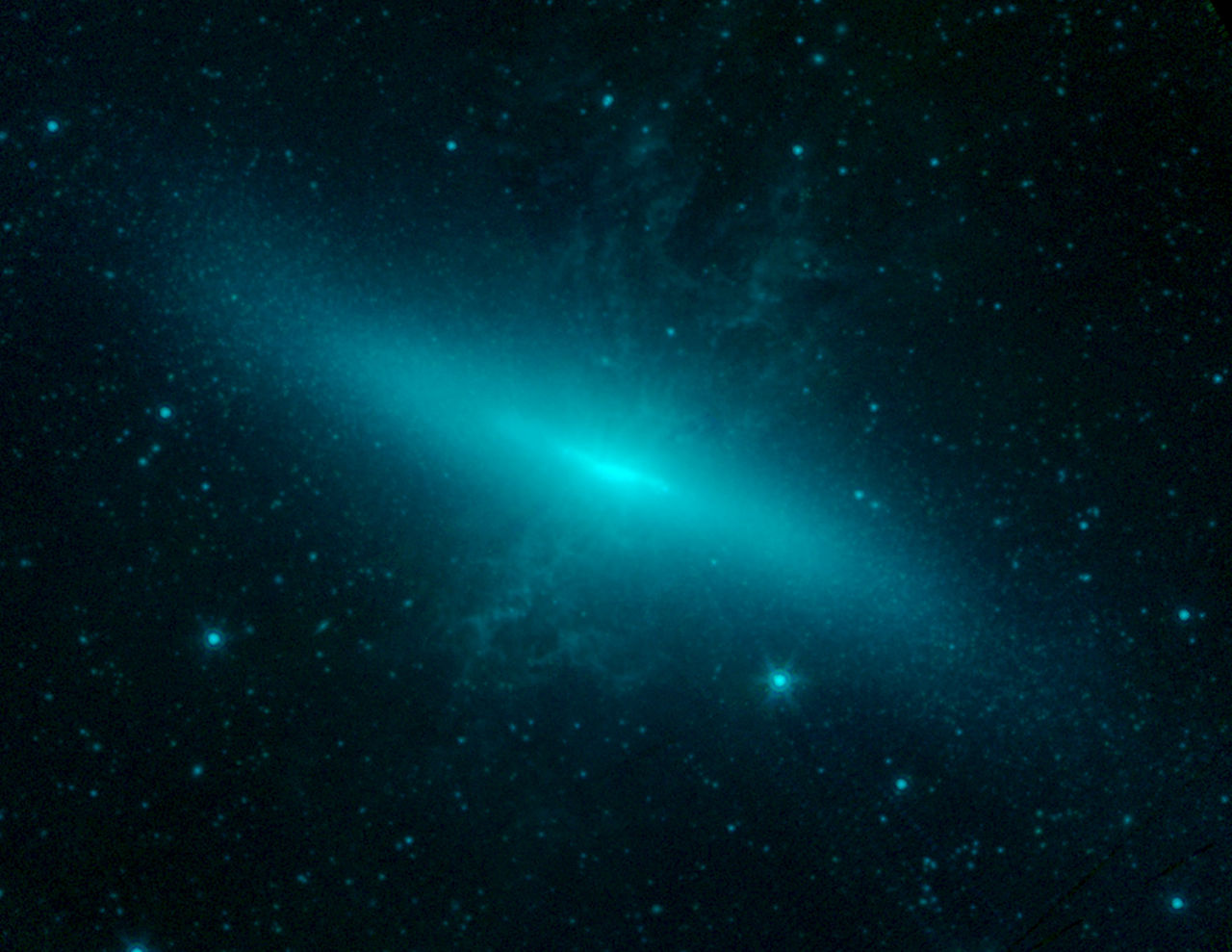
The stars in the Cigar Galaxy’s disk appear to have formed about 500 million years ago and are found in more than 100 clusters similar to globulars but younger. Star forming activity in the disk stopped about 100 million years ago and there is no evidence of star formation occurring anywhere outside the central starburst region. Star formation in the halo has been low for the last billion years. This indicates that the Cigar Galaxy was a low surface brightness galaxy before its encounter with M81, which triggered a burst of star formation.
The supermassive black hole at the centre of M82 has a mass of about 30 million solar masses.
The first intermediate-mass black hole candidate, with an estimated mass of 200 to 5,000 solar masses, was detected by the Chandra X-ray Observatory about 600 light years from the centre of the Cigar Galaxy.
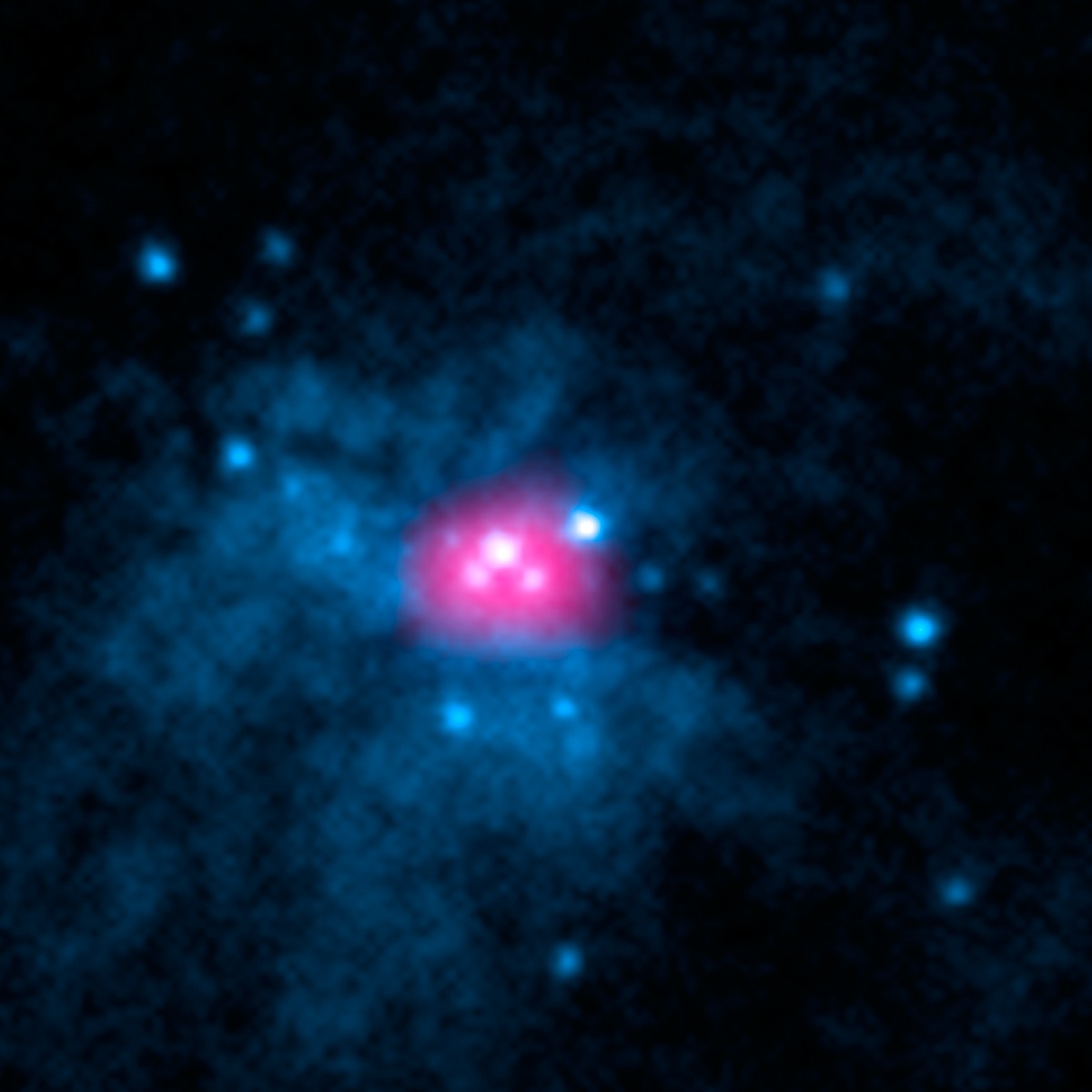
The image is a combination of high-energy X-ray data taken by NuSTAR (pink) and lower-energy X-rays captured by NASA’s Chandra X-ray Observatory (blue). Image: NASA/JPL-Caltech/SAO. High energy X-rays (pink): NuStar. Low energy X-rays (blue): Chandra X-ray Observatory.
In 2014, the brightest pulsar known was discovered in M82. Pulsars are dense remnants of stars that ended their life in supernova explosions. The pulsar in M82 was given the designation M82 X-2. Its luminosity is 100 times greater than its mass should be able to produce, in theory. The pulsar is classified as an ultraluminous X-ray source (ULX).
Supernova
A Type Ia supernova, named SN 2014J, was detected in the Cigar Galaxy on January 21, 2014. At the time of discovery, the supernova had an apparent magnitude of 11.7. By January 23, it brightened to 10.9.
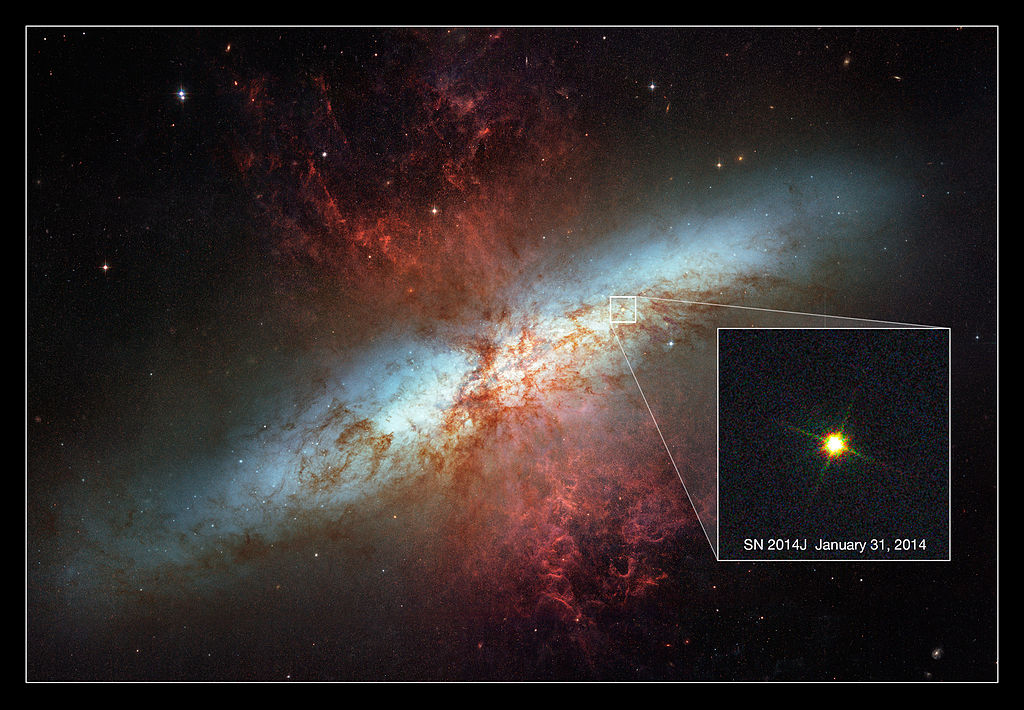
Several other probable supernovae were discovered in M82: SN 2004am (type II), SN 2008iz (type II) and another possible supernova reported in June 2009.
Unknown object
An unknown object in M82 was reported by radio astronomers at the Jodrell Bank Observatory of the University of Manchester in April 2010. The radio waves emitted by the object did not look like anything ever detected before and the source of the emissions is still uncertain. There have been several theories about the identity of the source, but none of them match the data. One of the theories suggested that it was an unusual microquasar, but this is unlikely because the object’s X-ray emissions are below the threshold for a microquasar.
The object was detected several arc seconds from the galaxy’s centre and is not likely to be associated with the central black hole in M82. It has a high apparent superluminal motion, four times the speed of light relative to the centre of M82, which is consistent with relativistic jets in supermassive black holes, but does not mean that the unknown object itself is moving faster than the speed of light.
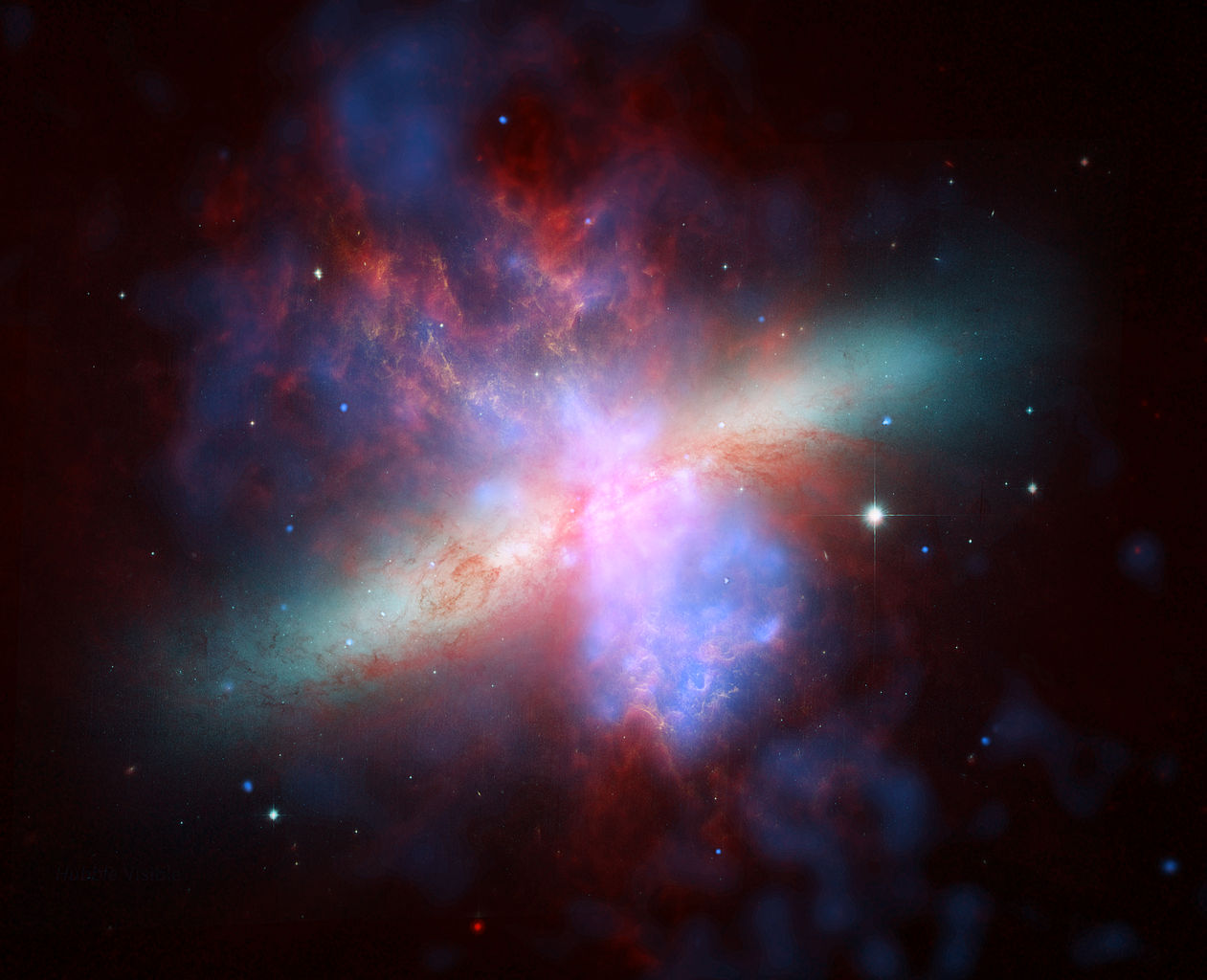
The Cigar Galaxy was discovered by the German astronomer Johann Elert Bode on December 31, 1774 together with the neighbouring Messier 81 (Bode’s Galaxy). Bode described the pair as “two small nebulae 3/4 degrees separated,” and wrote:
On December 31, I found through the seven-foot telescope, closely above the head of UMa, east near the star d at its ear, two small nebulous patches separated by about 0.75 degrees, the positions of which relative to the neighbored small stars are shown in the tenth figure. The patch Alpha [M81] appears mostly round and has a dense nucleus in the middle. The other, Beta [M82], on the other hand, is very pale and of elongated shape. I could determine the separation of Alpha to d as 2deg 7′, to Rho as 5deg 2′ and to 2 Sigma as 4deg 32′ with some accuracy; Beta was too faint and disappeared from my eyes as soon as I shifted apart the halves of the objective glass.
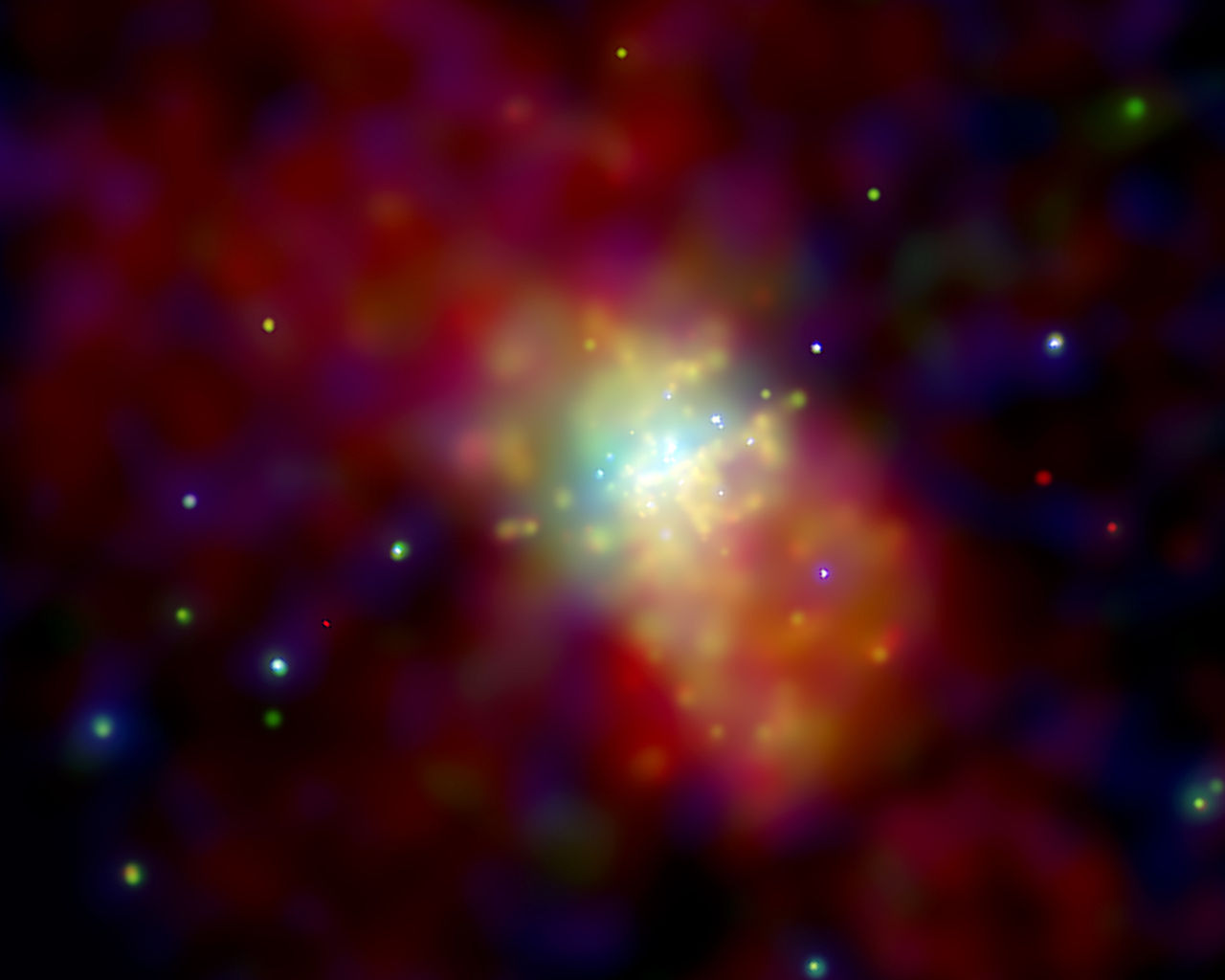
The object was independently discovered by Johann Gottfried Koehler between 1772 and 1778 and later by Charles Messier’s friend and colleague Pierre Méchain in August 1779. Koehler described M81 and M82 as “two nebulous stars at the ear of the Great Bear.”
Messier determined the positions for both M81 and M82 and added them to his catalogue on February 9, 1781. He wrote:
Nebula without star, near the preceding [Messier 81]; both are appearing in the same field of the telescope, this one is less distinct than the preceding; its light faint & elongated: at its extremity is a telescopic star. Seen at Berlin, by M. Bode, on December 31, 1774, & by M. Méchain in the month August 1779.
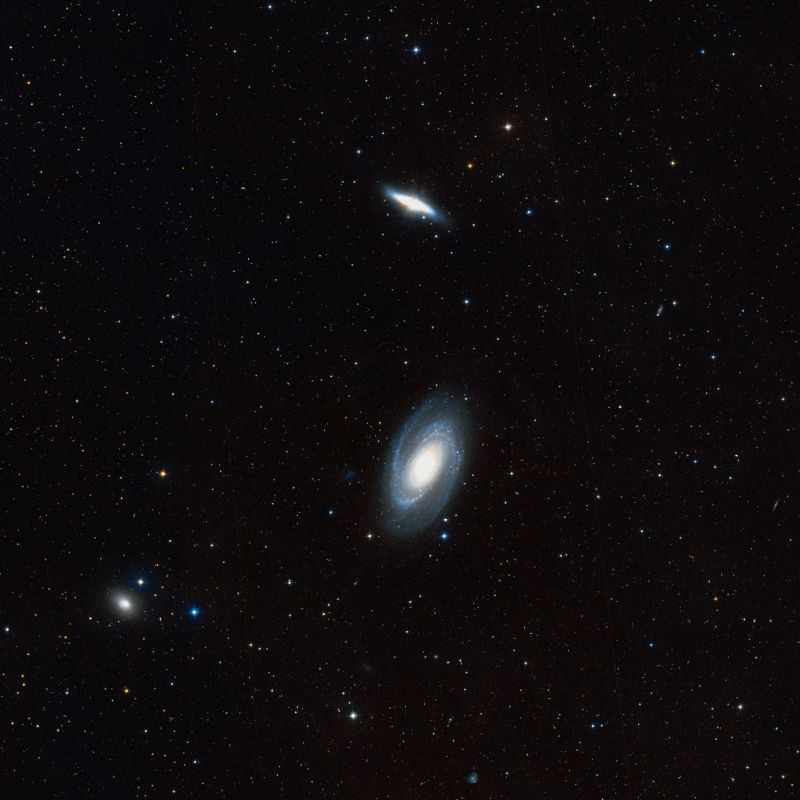
The Cigar Galaxy was catalogued as H IV.79 by William Herschel, who saw it on September 30, 1802. Herschel described it as a “very bright, beautiful ray of light, about 8′ long, 2′ broad; brightest in the middle of all its lengths. Follows 27 Ursae (Groombridge 1563) 14m 12s, and is 2deg 27′ south of that star.”
John Herschel added the object to the General Catalogue as GC 1950, calling it a “beautiful ray” which was “very bright; very large; very much extended.”
William Henry Smyth observed M81 and M82 in March 1837 and noted:
No. 81 is a fine bright oval nebula, of a white colour, in the Great Bear‘s ear, which was first registered by M. Messier in 1781, and exhibited a mottled nebulosity to WH [William Herschel]. Its major axis lies np [north preceding, NW] to sf [south following, SE]; and it certainly is brightest in the middle. There are several minute companions [stars] in the field, of which a close double star in the sp [south preceding, SW] quadrant is No. 1386 in Struve’s grand Catalogue, and by him marked vicinae; the members are both of 9th magnitude, and trend np [north preceding, NW] to sf [south following, SE], about 2″ apart, forming a fine though difficult object.
With a low power, No. 82 M. can be brought into the north part of the same field of view, although they are half a degree apart. It is very long, narrow, and bright, especially at its northern limb, but rather paler than No. 81. A line drawn through three stars in the sp [south preceding, SW] to a fourth in the nf [north following, NE] passes directly through the nebula. The two nebulae precede Lambda, in the end of Draco‘s tail, by 25deg, but as the vicinity is deficient of large stars, they are not readily fished up.
The apparent place here taken, is that of a small star between the two nebulae, which was differentiated with 29 Ursae Majoris, and every care taken in the reduction. The bright star in the animal’s chest, south of 29, viz. Phi, is pronounced to be double, both companions being of the 5th magnitude, and only half a second asunder.
William Parsons, 3rd Earl of Rosse, was the first to note the dark dust lanes in the galaxy’s central region.
Halton Arp included M82 in his Atlas of Peculiar Galaxies as Arp 337.
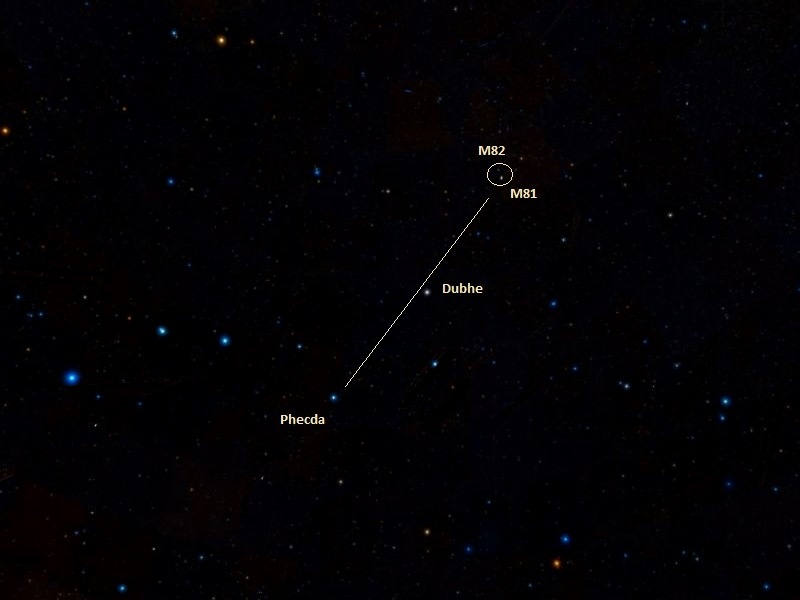
FACTS
| Object: Galaxy |
| Type: Irregular |
| Class: I0 |
| Designations: Messier 82, M82, NGC 3034, Cigar Galaxy, Arp 337, PGC 28655, UGC 5322, 3C 231, BWE 0951+6954, DA 277, 2E 2197, 2E 0951.7+6955, GB6 B0951+6955, IRAS 09517+6954, INTREF 396, KPG 218b, 2MASX J09555243+6940469, MCG+12-10-011, NRAO 341, NVSS J095551+694046, PRC D-13, RAFGL 1388, RBS 809, RGB J0955.9+6940, RX J095550+69406, Z 333-8, Z 0951.7+6955, SDSS J095551.73+694048.6, UT 0951+699, UZC J095557.0+694110 |
| Features: Starburst galaxy |
| Constellation: Ursa Major |
| Right ascension: 09h 55m 52.2s |
| Declination: +69°40’47” |
| Distance: 11.4 – 12.4 million light years (3.5 – 3.8 megaparsecs) |
| Number of stars: > 30 billion |
| Apparent magnitude: +8.41 |
| Apparent dimensions: 11′.2 x 4′.3 |
| Diameter: 37,000 light years |
| Redshift: 203 km/s |
LOCATION
